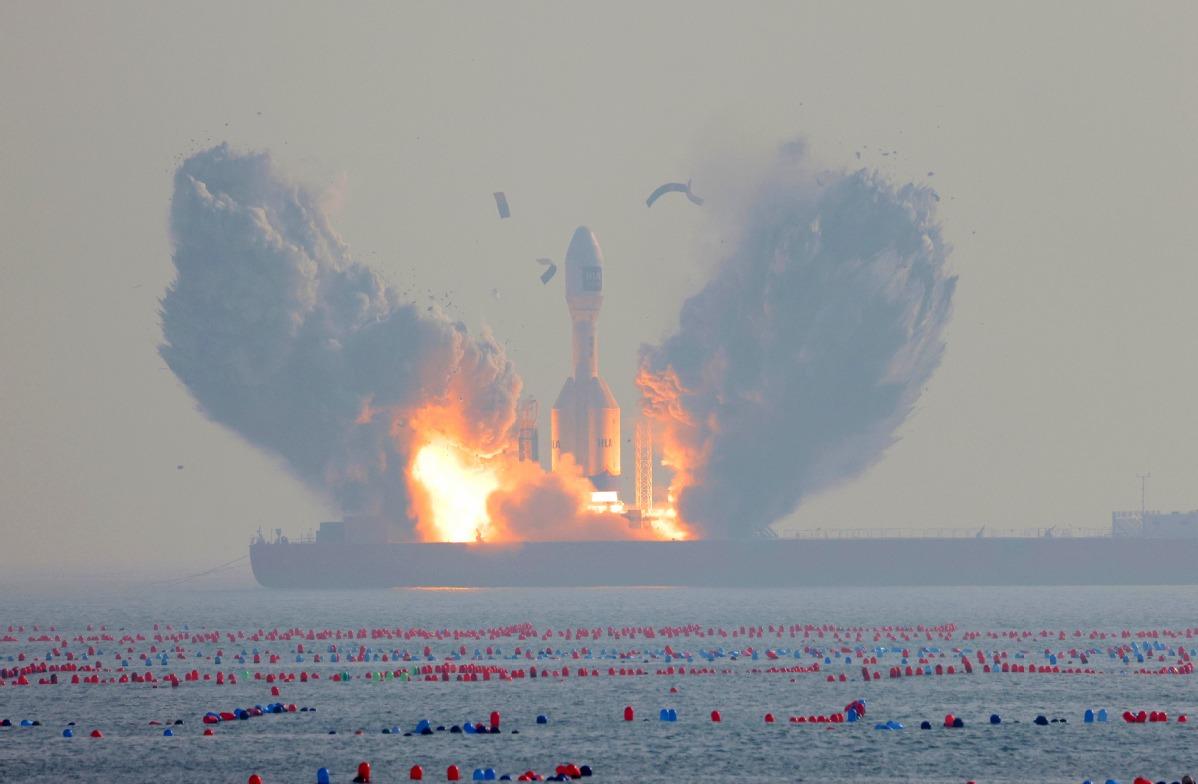Orienspace's Gravity 1 becomes new option for higher-payload missions
 Gravity 1 commercial carrier rocket lifts off from a launch vessel off the coast of Haiyang, Shandong province, on Jan 11, 2024. The rocket, the most powerful solid-propellant launch vehicle, transported three remote-sensing satellites into orbit, about 500 kilometers above the ground. (PROVIDED TO CHINA DAILY)
Gravity 1 commercial carrier rocket lifts off from a launch vessel off the coast of Haiyang, Shandong province, on Jan 11, 2024. The rocket, the most powerful solid-propellant launch vehicle, transported three remote-sensing satellites into orbit, about 500 kilometers above the ground. (PROVIDED TO CHINA DAILY)
Orienspace, a private space company, on Thursday carried out the debut flight of its Gravity 1 rocket, which has become the most powerful solid-propellant launch vehicle in the world.
The 30-meter-tall rocket blasted off at 1:30 pm from a launch service ship off the coast of Haiyang in Shandong province and soon transported three remote-sensing satellites into an orbit about 500 kilometers above the ground.
The Gravity 1 rocket model consists of three core stages and four boosters, all powered by solid-propellant motors and equipped with flexible swinging nozzles.
It has a liftoff weight of 405 metric tons and a liftoff thrust of 600 tons.
The rocket is able to send spacecraft with a combined weight of 6.5 tons into a low-Earth orbit, or 4.2 tons into a typical sun-synchronous orbit at an altitude of 500 km, according to Orienspace, which was founded in 2020 by a group of veteran researchers from State-owned space enterprises.
The specifications of its overall weight and carrying capacity mean that Gravity 1 is now the world's mightiest solid-fueled launch vehicle and also the most powerful of all Chinese private rockets.
In addition, it is the first and only private rocket in China that has side boosters. It also has the biggest fairing, or nose cone — the top structure on a rocket that contains satellites or other payloads — of the country's private rockets.
The type's successful maiden flight also made Orienspace only the fifth private Chinese company to have its own carrier rocket, following i-Space, Galactic Energy, Space Pioneer and LandSpace.
Orienspace said Gravity 1 is an ideal option for deploying large groups of satellites into low- and mid-altitude orbits or sending large spacecraft in emergency response scenarios.
 The Gravity 1 rocket, the world's most powerful solid-propellant launch vehicle, makes its debut flight off the coast of Haiyang in Shandong province, Jan 11, 2024. (WANG XIAOYU / FOR CHINA DAILY)
The Gravity 1 rocket, the world's most powerful solid-propellant launch vehicle, makes its debut flight off the coast of Haiyang in Shandong province, Jan 11, 2024. (WANG XIAOYU / FOR CHINA DAILY)
Bu Xiangwei, Orienspace's co-CEO and Gravity 1's chief designer, said the rocket's research and development started in March 2021 and involved about 100 engineers at the company.
"We overcame a lot of technical difficulties and developed a number of advanced technologies. My team conducted nearly 2,000 ground tests to ensure the rocket could be ready for flight," he said on Wednesday in Haiyang.
The rocket boasts large transportation capacity, big payload space and good operational economy, Bu said, adding that it can perform both sea- and land-based missions and can be used at short notice.
"Gravity 1 is capable of carrying a total of 30 lightweight satellites in a single flight. It also can take a large, heavyweight satellite or even a small cargo spaceship into orbit," the executive said.
He explained why the company chose to carry out Gravity 1's first launch at sea.
"The ground-based launch service infrastructure is far from sufficient to meet the demand from the country's commercial space sector. And even State-owned launch centers have allocated some of their facilities for private enterprises' commercial missions, it is still very difficult to bring large rockets there due to restraints in the existing transport infrastructure," the rocket designer said.
"By comparison, in sea-based operations, there are several commercial launch service vessels that we can rent. Using a ship allows us to launch our rockets in accordance with our own schedule, and make multiple launches in a short period," Bu said. "Other advantages include that launching rockets from the sea has fewer safety concerns because the rocket's debris is less likely to fall on densely populated areas, and that it promises a very wide variety of launch locations and all flight directions."
Orienspace has established several production, assembly and testing complexes in Haiyang, enabling it to conveniently move rockets to launch service ships, according to Bu.
Wang Yanan, editor-in-chief of Aerospace Knowledge magazine, said that over the past several years, private enterprises have risen as a new force in China's rocket industry.
"Twelve rockets built by private Chinese companies were launched in 2023, more than doubling that number in 2022," he said. "The rapid expansion of domestic private satellite businesses means that more rockets are needed, and those demands can only be met through the fast growth of the private rocket fleet because rockets from State-owned contractors are predominantly used by government-funded programs," he said.
The satellites deployed during Thursday's launch were built by Changguang Satellite Technology, a State-owned enterprise in Jilin province, and will be operated by Tianjin Yunyao Aerospace Technology for meteorological analysis and forecasting, spatial environmental detection, and ground disaster research and prevention.


